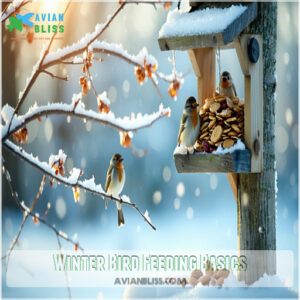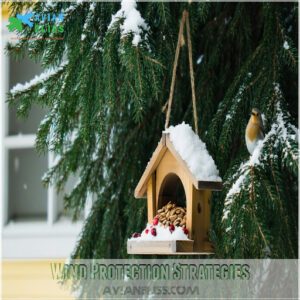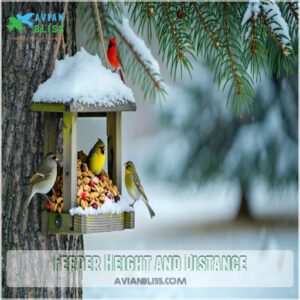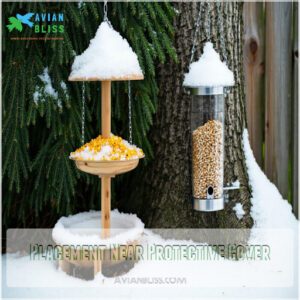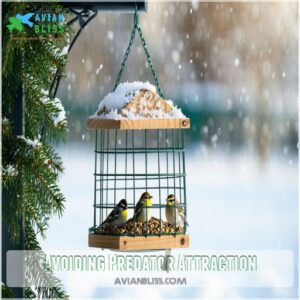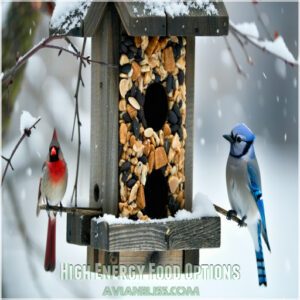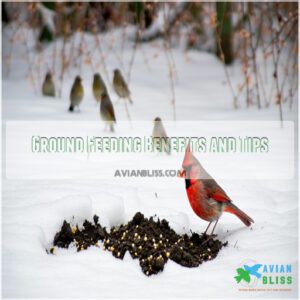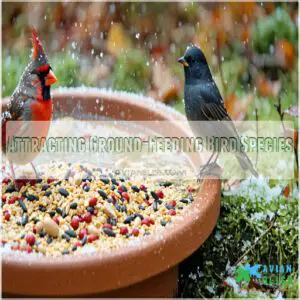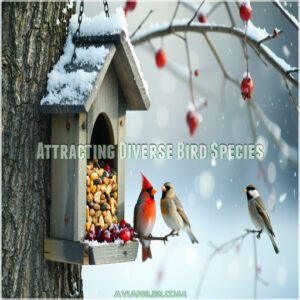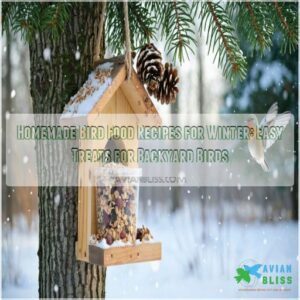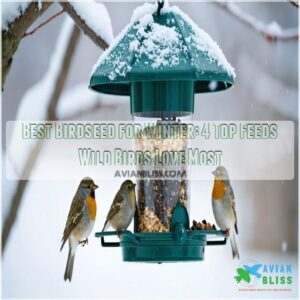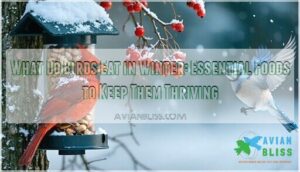This site is supported by our readers. We may earn a commission, at no cost to you, if you purchase through links.
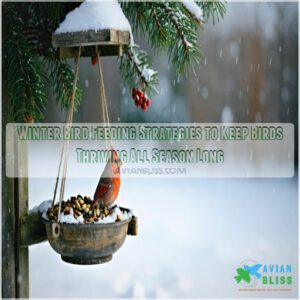
Set up feeders in sheltered spots, like near shrubs or fences, to protect them from wind and predators. Keep feeders 5-6 feet off the ground and spread them out to attract different species.
Refill feeders in the morning and evening for consistent food access. Don’t forget water—heated birdbaths are a lifesaver when everything’s frozen.
A little effort goes a long way in keeping birds happy and thriving all winter with consistent food access.
Table Of Contents
- Key Takeaways
- Winter Bird Feeding Basics
- Bird Feeder Placement Tips
- High Energy Food Options
- Ground Feeding and Birdbaths
- Attracting Diverse Bird Species
- Frequently Asked Questions (FAQs)
- What’s the best thing to feed birds in the winter?
- What is the 5 7 9 rule for bird feeders?
- Should you leave bird feeders out in winter?
- How to attract birds to bird feeders in winter?
- How to prevent squirrels from raiding bird feeders?
- What are safe ways to store birdseed?
- How to clean bird feeders effectively and safely?
- What types of feeders deter larger, aggressive birds?
- How to attract nocturnal bird species in winter?
- Conclusion
Key Takeaways
- Offer high-energy foods like suet, black oil sunflower seeds, and peanut butter to help birds stay warm and energized.
- Place feeders in sheltered spots near shrubs or fences, 5-6 feet off the ground, to protect birds from wind and predators.
- Refill feeders in the morning and evening for consistent food access, and use heated birdbaths to provide fresh water during freezing weather.
- Create multiple feeding zones with varied food types and heights to attract diverse bird species while reducing competition.
Winter Bird Feeding Basics
Feeding birds during winter keeps them energized and helps them survive harsh conditions.
You’ll need to focus on timing, variety, and proper placement to make your feeders a reliable source of sustenance.
Morning Feeding Importance
Starting your morning routine with dawn feeding boosts bird activity. Birds rely on early nutrition to recharge after long, cold nights.
Morning feeding supports their energy for foraging and survival. Sticking to feeding schedules maintains consistency.
As part of your winter bird feeding strategies, this simple morning maintenance offers vital help for bird feeding in winter, enhancing their winter survival tips.
Evening Refilling Benefits
Refilling bird feeders in the evening gives birds a reliable food source during colder nights, boosting their energy for winter survival.
Offering diverse food options attracts a wider variety of birds to your backyard.
Evening feeding also complements your morning routine, ensuring consistent feeding habits.
Plus, it’s a great time for feeder maintenance—clear debris and add fresh seed.
This timing helps support bird activity and keeps your winter bird feeding strategies effective and simple.
Cold Weather Feeding Strategies
Cold weather birds need extra care to survive. Focus on winter bird feeding strategies like offering high-energy food such as suet, peanuts, and sunflower seeds.
Consider supplemental winter fruits like apples and grapes.
Use heated bird baths to solve icy water challenges. Refill Frosty Feeder Care stations in mornings to help birds’ cold climate adaptation.
Clear snow for Winter Foraging and manage frozen seed for easy access. Help birds thrive by utilizing high-energy food sources.
Creating Multiple Feeding Zones
Creating multiple feeding zones is one of winter bird feeding’s best secrets.
Spread out feeders at different heights and locations for less competition.
Use zone creation to encourage bird diversity by offering varied seed types.
Hang some feeders high, place others closer to the ground.
Feeder placement near cover adds safety, while variety keeps birds happy and returning, utilizing bird diversity to its fullest potential.
Bird Feeder Placement Tips
Where you place your bird feeders can make a big difference in attracting birds and keeping them safe.
By choosing spots with wind protection, proper height, and shelter from predators, you’ll create a welcoming and secure feeding environment.
Wind Protection Strategies
Picking the right spot for feeders makes a big difference in cold climates. Use natural wind breaks like shrubs or fences for wind protection.
Place feeders on the south or east side of your home to shield against strong gusts.
Snow cover adds some insulation for ground-feeding birds. These simple bird feeding strategies improve winter survival and create cozy bird shelters to enhance winter survival.
Feeder Height and Distance
Bird feeders work best when hung 5-6 feet above ground, balancing bird visibility with predator safety.
You can find more information on ideal bird feeder heights.
Height adjustment and distance optimization guarantee safe, stress-free feeding birds.
Place feeders over 10 feet from shrubs to deter hiding predators.
Want fewer squirrels? Invest in squirrelproof feeders.
Proper feeder placement increases enjoyment and keeps birds comfortable during winter bird feeding—an easy win-win for you and them, promoting overall winter bird feeding.
Placement Near Protective Cover
Placing feeders near shrubs or trees gives birds a shelter for quick safety. Shrub placement and tree cover provide excellent wind protection and help birds conserve energy.
Use your yard layout wisely—set feeders within 10 feet of cover to balance accessibility and predator defense.
Adding fence protection nearby boosts safety further, while keeping bird baths sheltered reduces freezing risk.
Avoiding Predator Attraction
To protect birds from predators like cats, foxes, or hawks, keep feeders safe:
- Add feeder guards: Use cages or baffles to block predators.
- Maintain distance: Place feeders 10 feet from shrubs for predator avoidance.
- Secure feeders: Keep them stable to prevent tipping.
- Check surroundings: Avoid areas attracting predators with easy cover.
Prioritize bird safety with predator control measures.
High Energy Food Options
Providing high-energy foods like black oil sunflower seeds, suet, and peanut butter can help birds stay warm and energized during freezing temperatures.
These calorie-packed options are essential for building fat reserves and keeping birds active all winter long, which is crucial for their survival with the help of high-energy foods.
Black Oil Sunflower Seeds Benefits
Black oil sunflower seeds are a go-to for winter bird feeding. Their high oil content packs a punch of energy, helping birds stay warm.
With thin shells, they’re easy to crack, making them perfect for smaller species.
Offering convenient black oil sunflower seed products, this birdseed supports diverse winter birds, offering high-quality bird attraction.
Keep feeders stocked—it’s smart feeding tips like this that keep feathered friends thriving, with high-quality bird attraction always being the goal.
Suet and Peanut Butter Advantages
Suet and peanut butter are winter bird feeding secrets you’ll want to try. These high-energy foods help birds stay warm and thrive.
Woodpeckers especially benefit from high-energy suet recipes.
- Suet benefits: Packed with fat, it supports bird nutrition and boosts energy.
- Peanut butter: A sticky, high-energy treat preferred by woodpeckers and chickadees.
- Quick tip: Spread unsalted peanut butter on pine cones for a simple homemade feeder.
Fresh Fruits and Berries Importance
Adding fresh fruits and berries to your winter bird feeding secrets can make a big difference.
Birds love high-calorie foods like cut apples, oranges, and grapes.
Fruit nutrition helps them stay strong, especially during harsh days.
Offering winter bird feeding fruit products can supplement natural food sources.
Winter fruits and berries, like rowan or holly, provide variety and energy.
Keep pieces small, and watch birds flock for these fresh options that offer a big difference in their diet!
Mealworms and Niger Seeds Uses
Mealworms and niger seeds are perfect high-energy foods for winter bird feeding.
Mealworms provide fat and protein, essential for warmth and egg-laying prep.
Consider live vs. dried mealworms as options.
Niger seeds are a bird nutrition powerhouse, attracting finches and sparrows with nourishing oils.
Use tube feeders for niger seeds and offer mealworms occasionally to complement seed mixtures.
These feeding techniques keep birds thriving all season.
Ground Feeding and Birdbaths
Ground feeding and birdbaths provide essential food and water sources when natural options are scarce in winter.
Clearing snow, scattering seed, and keeping birdbaths ice-free can help ground-feeding birds stay healthy and hydrated.
Ground Feeding Benefits and Tips
When it’s snowy, ground feeding offers great bird attractions.
Clear feeding areas of snow and toss high-energy food like black oil sunflower seeds or millet.
Ground feeders like cardinals and juncos appreciate scattered winter bird food.
Verify that seed selection avoids pests by sticking to quality bird seed.
Ground feeding adds variety to your winter bird feeding tips while keeping things simple and providing a way to appreciate winter bird food.
Birdbath Maintenance and Heating
Keeping bird baths functional in winter helps your feathered friends stay hydrated.
Prevent bird bath freezing with these tips:
- Use a birdbath heater or de-icer for water heating.
- Clean bird baths regularly with a water-vinegar mix for proper bath maintenance.
- Avoid concrete baths—they crack in freezing weather. Stick to shallow, sturdy options.
Winter birding thrives with clean, safe water!
Fresh Water Importance in Winter
Water is life, even in winter birding.
Frozen Pond Management can leave birds thirsty, so Winter Birdbaths offer Ice Free Solutions.
Use shallow containers and Thawing Techniques, like heated bird baths, to keep Fresh Water Sources accessible.
Refresh water twice daily to prevent freezing.
These small steps in bird conservation guarantee winter wildlife stays hydrated and healthy, even in harsh conditions, with Fresh Water Sources and heated bird baths.
Attracting Ground-Feeding Bird Species
To attract ground feeders like cardinals and juncos, clear snow and scatter high-energy foods like black oil sunflower seeds, millet, or peanuts.
Choose sheltered feeding zones to protect birds from wind.
Bird baths can double as feeding spots by adding seed. A ground bird bath for small yards offers an essential water source.
Ground feeding reduces competition and helps diverse bird species thrive, it’s a simple winter bird survival strategy that supports a diverse bird community.
Attracting Diverse Bird Species
You can attract a variety of bird species by offering a mix of foods like seeds, suet, and fruits.
Creating a safe, sheltered environment with feeders at different heights will make your yard a favorite winter stop for local birds, by providing a place where they can find seeds.
Understanding Bird Preferences
Bird preferences vary by species, so knowing their feeding habits can make your yard a hotspot.
Understanding bird behavior feeding patterns is essential for attracting diverse species.
Cardinals love sunflower seeds, while goldfinches prefer niger seeds.
Robins enjoy fruit, and woodpeckers go wild for suet.
Keep these tips in mind:
- Cardinals: Black oil sunflower seeds.
- Goldfinches: Niger seeds.
- Robins: Fresh fruits.
- Woodpeckers: Suet and peanut butter.
Offering Varied Food Sources
Mixing up bird food keeps your feathered friends happy.
Offer a seed variety like black oil sunflower seeds and millet.
Add fruit options such as apples and oranges, and try suet types for high-energy food.
Nut offers, like peanuts, are a hit too.
Berry choices from shrubs or trees round out the menu, attracting diverse species.
Creating a Bird-Friendly Environment
Creating a bird-friendly environment starts with thoughtful garden design. Use native plants to build a natural bird habitat, supporting wildlife conservation.
Winter gardens shine with berry-producing shrubs and evergreens.
To make your space eco-friendly and inviting:
- Plant trees like viburnum or holly for shelter.
- Add shrubs with seeds or berries.
- Provide windbreaks for cozy feeding spots to create a natural bird habitat.
Identifying and Attracting Local Bird Species
To identify local bird species, observe feather patterns, beak shapes, and migration patterns.
Use field guides or apps to match winter bird species in your area.
Tailor bird attracting techniques by offering foods they love, like black oil sunflower seeds or suet.
Study local habitats to adjust feeder placement.
These winter feeding tips will help support diverse local bird species by providing them with winter feeding essentials.
Frequently Asked Questions (FAQs)
What’s the best thing to feed birds in the winter?
When the temperature drops like a stone, offer high-fat foods like suet, peanuts, and black oil sunflower seeds.
These calorie-packed options help birds stay warm, build energy reserves, and survive winter’s frosty grip.
What is the 5 7 9 rule for bird feeders?
The 5-7-9 rule helps prevent bird collisions with windows. Place feeders either within 5 feet of a window, 7 feet from reflective surfaces, or over 9 feet away to keep birds safe.
Should you leave bird feeders out in winter?
Imagine a lifeline in the snow—yes, leave your bird feeders out in winter.
Birds rely on them for energy during freezing months.
Keep them filled, clean, and sheltered to support their survival and activity.
How to attract birds to bird feeders in winter?
Place feeders near shelter, like shrubs or trees, for protection.
Use high-fat foods like suet, sunflower seeds, and peanuts.
Add a heated birdbath for water. Refill feeders often, especially in the morning and evening.
How to prevent squirrels from raiding bird feeders?
Think of squirrels as clever gymnasts.
Use baffles below pole-mounted feeders or above hanging ones.
Place feeders 10 feet from jumping points.
Grease poles lightly, and offer squirrels their own food to divert attention.
What are safe ways to store birdseed?
Store birdseed in airtight containers to keep it fresh and pest-free.
Use metal or thick plastic bins to prevent rodents from chewing through.
Keep it in a cool, dry place, away from sunlight and moisture.
How to clean bird feeders effectively and safely?
Don’t worry about it being complicated! Scrub feeders with warm, soapy water weekly, rinse thoroughly, and air-dry.
For tough grime or germs, use a 1:9 bleach-water mix.
Clean more often during heavy use or wet weather.
What types of feeders deter larger, aggressive birds?
Use tube feeders with small perches or weight-sensitive feeders that close under heavier birds.
These designs discourage larger, aggressive birds like grackles or starlings.
They allow smaller species to feed comfortably and safely, which is the primary goal of using such feeders.
How to attract nocturnal bird species in winter?
To attract nocturnal birds like owls, place suet, meat scraps, or mealworms in quiet, open areas.
Install nest boxes near trees for shelter.
Avoid bright lights; dim environments encourage nighttime feeding and roosting.
Conclusion
Did you know over 40% of bird species rely on backyard feeders during winter?
By using smart winter bird feeding strategies, you’re giving birds the energy they need to survive harsh conditions.
Keep feeders stocked with high-energy foods like suet and sunflower seeds, place them in sheltered spots, and add a heated birdbath for water.
A little effort guarantees birds stay healthy and happy all season long, while you enjoy their beauty and songs nearby.
- https://www.birdsandblooms.com/birding/attracting-birds/feeding-birds/top-tips-winter-bird-feeding/
- https://www.dnr.state.mn.us/birdfeeding/winter.html
- https://www.homesandgardens.com/advice/feeding-birds-in-winter
- https://naturalresources.extension.wisc.edu/five-tips-for-winter-bird-feeding/
- https://gl.audubon.org/news/dos-and-don%E2%80%99ts-winter-bird-feeding

